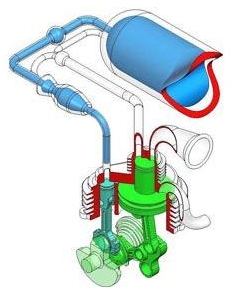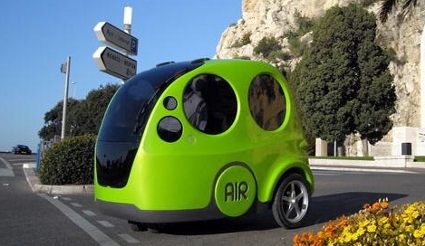Car runs on compressed air
Last updated Nov 8, 2008 — 14353 views Air France and KLM have announced plans to conduct a six-month trial of a new zero-emission, compressed-air powered vehicle. The “AirPod” seats three, can do 28 mph, and goes about 135 miles on a tank of compressed air.
Air France and KLM have announced plans to conduct a six-month trial of a new zero-emission, compressed-air powered vehicle. The “AirPod” seats three, can do 28 mph, and goes about 135 miles on a tank of compressed air.
The AirPod was developed by MDI (Motor Development International), under the direction of company founder and CEO Guy Negre. Initially, the vehicle will be manufactured in India by Tata Motors, and distributed in France and India.
MID’s AirPod compressed air vehicle
(Photo source: MID)
 The AirPod is 6.7 feet long and weighs 485 pounds. The driver controls the motion of the vehicle with a joystick.
The AirPod is 6.7 feet long and weighs 485 pounds. The driver controls the motion of the vehicle with a joystick.
The vehicle has four wheels, and uses rear-wheel drive. Refueling the vehicle’s 46 gallon (175 liter) compressed air tank tank only takes a couple of minutes, according to the company.
MID expects the AirPod to reach production by mid-2009, and to sell for around 6,000 Euro. Four other models, featuring speeds up to about 70 mph, are also on the drawing board.
AirPod demonstration and Q&A
Below are three YouTube videos that showcase and describe the AirPod. The first shows a prototype AirPod being tested in Nice, France. In the second and third videos, MID R&D manager Cyril Negre discusses the AirPod’s technology and capabilities.
Airpod prototype demonstration in Nice, France
(Click image to play video)
Q&A on AirPod with Cyril Negre — Part 1
(click image to play video)
Q&A on AirPod with Cyril Negre — Part 2
(click image to play video)


Further information
Air France Industries and KLM Engineering and Maintenance will be evaluating the AirPod from the perspective of safety, ergonomics, deployment, reliability, and maintenance costs, among other factors.
For more details, visit MDI’s website.
Note: The above videos were produced by Catvolution.com, a website devoted to “using the power of the Internet to help bring these amazing compressed air vehicles to the North American market.”



This actually makes the SMART car look attractive.
I’ve looked at compressed air and other forms of energy storage and, while it looks useful in limited applications such as this one (a 28 mph, 500 pound vehicle), unless I’m missing something (and I may be), it doesn’t look usable for more normal automotive applications. If I did my units conversions correctly, even a 100 gallon tank at 5000 psi only holds about 4 kWh of energy. In the rough calculations I’m doing, that’s roughly the same as 5 hp-hours. So, for this AirPod to go 135 miles, it must use about 1 hp, which sounds doable — humans are about 1/20 hp. But a normal car at 60 mph needs about 15 hp, and even a lighter, more aerodynamic car at that speed is likely to be at least 5 hp (again, correct me if I’m wrong — I haven’t researched this lately), meaning that you’d have to refill the tank at least every 60 miles. Maybe OK for a commuter, but not a general purpose car used for commuting, family trips, etc. Unless capital, insurance and storage costs can be made small enough for a special purpose vehicle to be a reasonable addition to a family’s fleet, that seems to kill the possibility. Refueling is another problem, with a bit of chicken-and-egg issue. Until there are a large number of such cars, refueling stations won’t exist and vice versa. The same problem exists with electric vehicles, which is why I’ve been a long time fan (since at least 1994) of hybrid EV’s (or here it could be hybrid compressed air vehicles). Using a small gasoline engine provides a bridge to both the refueling infrastructure and the R&D investments needed to make these technologies viable.
compressing air is inefficient. What is the expected KWH/mile? But the 135 miles range is impressive.
The concept is fine, but this prototype is completely unacceptable for any market other than disneyland. Its appearance is absurd — looks more like a SeaMonkey bowl than an automobile and if it ran on onlooker’s laughter rather than compressed air, it would be a perpetual motion machine!
I must assume there is no air conditioning (since even an efficient A/C compressor requires 2hp, alone). Likely there is not provision for heat either (no waste heat due to no internal combustion engine) which makes it unworkable for all but the most temperate climates.
I think the compressed air engine’s place is as part of a hybrid air/electric or air/combustion hybrid. Alone, air power is not sufficient.
@jon
Actually, the company has several hybrid power source designs. Take a look on MDI’s website.
I think this is a great idea. Unfortunately the U.S. is so horsepower hungry that they won’t appreciate this transporter, but more intelligent, open-minded cultures will really appreciate it. I would love to have one myself.
Sorry – can’t work, do the math. Another “Buy stock now” company that will be gone in 2 years. Execs will be rich, everyone else broke.
Physics Major
Well, this looks doable for a vehicle to be used as an inner-city transportation system?
Ban gasoline/diesel vehicles or place a massive tax on them being used inside the city limits, then provide thousands of these things in multi-story parking garages. Drive to the outskirts of the city, park your regular vehicle, slot your “share card” and pick up one of these for the last 10 miles to work.
Suddenly, your daily commute becomes a soft, quiet time with breathable air all around.
As for air conditioning, that would come from the tank itself. As the car is running, the tank will become freezing cold as the compressed air is used up. Just run the air from inside the unit around it to make it cool.
My only concern is that the site says a fill-up only takes “a few minutes”. Ahhh, no. Doing a fill-up CORRECTLY will take 10-20 minutes. Fill it up too fast, and it will get red hot, unless you’re already using liquid air.
Cab you refuel at the tire pump?
No, you cannot refuel at a tire pump. Tire pumps only go up to around 60 psi. These vehicles store air at 300 bar (around 4500 psi).
Doubt it might be useful for mainstream highway applications due to safety reasons. A serious accident with of these, which might potentially rupture the 4,500 psi tank, could be like a bomb going off. Hmmm, mobile bombs…
Air compression is only inefficient if you waste heat. The typical compressor aims for isothermal compression, and the compressor is cooled by warming up the atmosphere. The trick is adiabatic compression, where the compressor is insulated and heat is not wasted. To keep temperatures reasonable, say 300 C, the compressor is cooled with water sprayed into the intake, and the compressed air/steam mixture is stored in insulated high-pressure tanks. On expansion, the steam condenses and reheats the air, so the input is ambient temperature air and water, and exhaust is ambient temperature air and distilled water. It is thermodynamically “perfect”. (US patent No. 5,832,728) This has been experimentally demonstrated; for the transmission of power, a compressor-expander was more efficient than an electric generator-motor.
One can store about 1 kWhr in a cubic foot. If you want an x-prize vehicle (four seats, 100 mph, 0-60 in twelve, 200 mile range), start with an extended cab pick-up truck and fill the bed with insulated tanks. The drive line is “stock” with a manual transmission and, preferably, a modified diesel engine. The expansion ratio can be adjusted by the timing of the electronically controlled common-rail injectors, injecting air rather than fuel. Heat is plentiful, and cooling can be had either with the stock A/C unit or by overexpanding the exhaust.
Air/steam (I call it wet compressed air) has several advantages over batteries, whether in a hybrid or in a “pure” zero-emissions car. There are no scarce or toxic batteries which must be recycled, or expensive copper motors. Air tanks are cheaper and scale well. You can store megaWatt-hrs in an underground or underwater tank at a tiny fraction of the cost of batteries. Recharging is easy. You can have an electrically driven compressor in your garage, or stop at a “gas” station to recharge in minutes. (No, the tanks will not get “red hot”) With the quick recharge, the range at highway speeds is “unlimited”, while with a battery vehicle, when you add in the recharging time, the average speed is comparable to a bicycle.
Um…anyone heard of the P.H.E.V. car? South Korea already did this back in 2000. *yawn*
By the time all of the vehicle safety requirements are met, you will have a car weighing well over twice the initial amount, and correspondingly reduced speed and range.
So what is the ACTUAL performance of the prototype in the video???
What is the ACTUAL top speed of the prototype ??????
What is the ACTUAL range of the prototype ??????
I’ve seen lots and lots of claims, but very very little in the way of actual performance test results.
Interesting concept. Look forward to seeing a final product. Will keep an eye on website.
By poking around archived versions of the previous MDI website, I found some performance info.
The ACTUAL TESTED RANGE of their prototype vehicle was only 7.22km! Less than 5 mile operating range! Then they said that the production car would only weight half that of the prototype, so range will be doubled to 14km/9 miles; and we’ll change from steel tanks to carbon fiber tanks and we’ll add stages to the air engine so the range will quadrupled beyond that to 55km/34 miles; and improve the distribution seal of the engine to multiply range another factors of 2.5 to 138km/86 miles; and we’ll make the engine run closer to isothermic for another factor of 1.4 for a predicted range of 191km/120miles; and then we’ll make the tanks bigger and higher pressure to get a predicted range of 242km/150miles.
See how easy it is to take the actual performance of less than 5 mile range and come up with a specification of 150 mile range! Now we know how they do it on paper. The problem is, apparently they have NEVER done it in real life.
Taking a 4.5mile actual test and turning that into a 120 or 150 operating range is so outrageous that you may think I’m making this up. But you can see for yourself by going to the archived MDI website pages on the wayback machine at archive.org:
http://web.archive.org/web/20070915070846/www.theaircar.com/tests.html
It’s nice to have this sort of stuff recorded on the internet in a way that it won’t disappear.
I have also made a compressed air vehicle. I m a mechanicl engg student. My vehicle is 80kg in weight and run 100m only on 20ltr,200psi. Compressed air rocks.